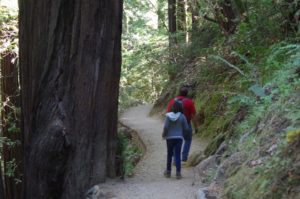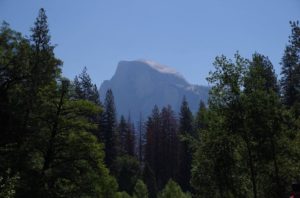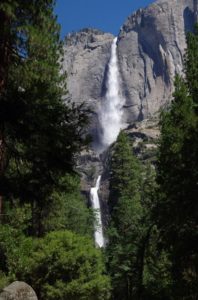This land is your land, this land is my land
From California to the New York Island
From the Redwood Forest, to the Gulf stream waters
This land was made for you and me–Woodie Guthrie
When my daughter was in preschool, she learned the lyrics to Woodie Guthrie’s folk song This Land Is Your Land. After one summer vacation, while she played in the Gulf stream waters off the coast of Florida, she asked, “Can we go see the Redwood Forest now?”
I had never seen the Redwood Forest, and my daughter’s request piqued my curiosity. I thought about my own childhood, when I had accompanied my older sister on a botany class project to collect plants and how curious I was about the plants and where they grew and what their names meant. Suddenly I wanted to see the Redwoods, and the Giant Sequoias.
It took a few years, but we managed to design a vacation trip that satisfied my daughter’s request to see the Redwood Forest and my growing curiosity, and I am so glad we did.
Our trip took us first to San Francisco where we visited Alcatraz Island, a fascinating piece of American history for more than just its years as a prison. Most notably (if you are a young reader), it is the place where Percy Jackson first encountered Kampe. Now the island is a bird sanctuary filled with snowy egrets and gulls and hosts of other winged visitors. The gardens on the island are amazing and reflect the diverse people who have inhabited the island over its history.
The next day we were off to Yosemite National Park. Here we would see Giant Sequoias, relatives of the Redwoods, Sequoias being the largest diameter trees in the world, Redwoods being the tallest. After Yosemite, we would move on to Muir Woods National Monument to see the Redwoods.
Although I had heard stories of Yosemite and vaguely understood that it was a jewel among our national parks, I did not fully appreciate it until I began to research and plan our hikes. Even with the planning that I did in the months leading up to our trip, I had no inkling of Yosemite’s true magnificence until I saw Yosemite Valley for the first time: It left me breathless and teary-eyed.
The United States is filled with natural wonders: the Bad Lands, Midwest prairies, the gentle Appalachians, the geysers of Yellowstone, Great Lakes, the forests of the Northwoods, the Everglades and bayous, extensive cave systems, deserts, tundra, beaches, and barrier islands. Each one with its own fascinating geology and biology to inspire and humble the visitor. I have been fortunate to see many of these places. These natural areas are a tremendous natural resource; to be a citizen of a country that is visionary enough to preserve these areas is an incredible privilege.
When I think about our National Park System and other protected areas, Theodore Roosevelt comes immediately to mind; perhaps it is because he doubled the number of parks in the park system during his presidency (1) and because he was a wilderness buff. However, as I learned from my daughter, who participated in Yosemite’s Junior Ranger program, the spark that led to the formation of the National Park System may well have been Senate Bill 203, proposed in the 38th Congress and signed into law on June 30, 1864, by President Abraham Lincoln.
Think about that.
In the midst of the bloodiest, most divisive conflict that the United States has ever seen, the American Civil War, which pitted brother against brother, the 38th Congress of the United States proposed and passed the Yosemite Grant Act, yielding to the State of California Yosemite Valley and the Mariposa Big Tree Grove under the “express conditions that the premises shall be held for public use, resort, and recreation; [and] shall be inalienable for all time” (2).
These senators, congressmen and the President, all of whom were facing one of the greatest crises our nation has ever faced, did something optimistic and hopeful—they protected a natural wonder for generations to come. The impassioned testimony in the Senate discussing the need to protect the Big Tree Grove is fascinating (2), and I highly recommend reading the few paragraphs recording the discussion of the bill. Eventually these lands were returned to federal ownership, and Yosemite became a national park, but the Yosemite Grant Act was unprecedented in that it set aside a natural area for protection, preservation and public access.
The 38th Congress was courageous—and curious as they asked questions and learned about these resources that they set out to protect. They stared divisiveness, politics and war down and acted to protect and preserve the future. As a consequence of their actions in 1864, a child born—not just in a different century, but in a different millennium—is able to hike these mountains, hug these big trees, and feel the mist from these great waterfalls.
The original vision of making these natural wonders available for all to enjoy and learn from has been further extended by the creation of the National Park Service, the protection and preservation of other natural lands and endangered species, and through programs that invite people into the parks such as the Junior Ranger program, which teaches children (and their parents) about each park they visit, and the “Every Kid in a Park” program, which lets fourth graders and their families spend a summer exploring the National Parks and Monuments without charge.
I’m so glad my daughter asked to see the Redwood Forest, for indeed this land was made for you and me—and for generations to come.
References
- National Park Service. Theodore Roosevelt and the National Park System. https://www.nps.gov/thrb/learn/historyculture/trandthenpsystem.htm (accessed 07/20/2017)
- The Library of Congress. American Memory: The Evolution of the Conservation Movement 1850–1920. https://memory.loc.gov/cgi-bin/query/r?ammem/consrvbib:@FIELD(NUMBER(vl001+vl499)) (accessed 07/20/2017)
Michele Arduengo
Latest posts by Michele Arduengo (see all)
- Using Dual-Luciferase Assays to Identify the Role of Non-Coding RNAs in Disease - May 2, 2025
- An Unexpected Role for RNA Methylation in Mitosis Leads to New Understanding of Neurodevelopmental Disorders - March 27, 2025
- Unlocking the Secrets of ADP-Ribosylation with Arg-C Ultra Protease, a Key Enzyme for Studying Ester-Linked Protein Modifications - November 13, 2024



